- “Films as History; Exploring Historiophoty”, the First of Illuminating Webinar Series June 4, 2021
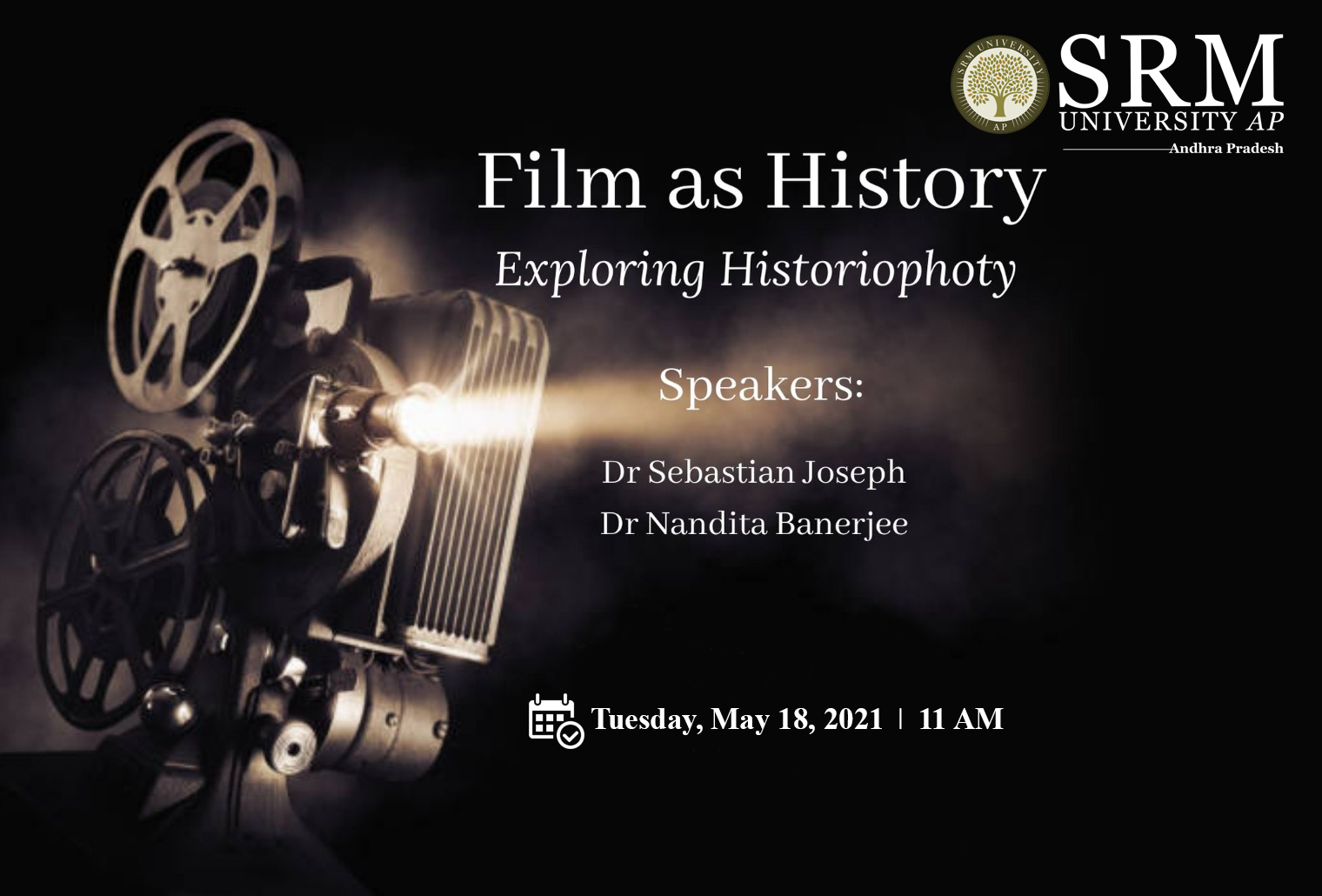 A webinar aimed to discuss the use of films in particular and visual images in general as sources for the reconstruction of History was organized by the Department of History on May 18, 2021. Films as History; Exploring Historiophoty, the first of the monthly Webinar series on new and exploratory themes in History, dealt with the promises and challenges of Historiophoty as a sub-stream of history. Following Hayden White’s pathbreaking analysis of visual imagery and its location in historiography, historiophoty has emerged as a most promising pathway for historians particularly as we move towards a rapidly digitizing world.
A webinar aimed to discuss the use of films in particular and visual images in general as sources for the reconstruction of History was organized by the Department of History on May 18, 2021. Films as History; Exploring Historiophoty, the first of the monthly Webinar series on new and exploratory themes in History, dealt with the promises and challenges of Historiophoty as a sub-stream of history. Following Hayden White’s pathbreaking analysis of visual imagery and its location in historiography, historiophoty has emerged as a most promising pathway for historians particularly as we move towards a rapidly digitizing world.Dr Sebastian Joseph, a Historian and Film Critic and recipient of the State Award for Best work on Film History 2020, and the author of Cochin Forests and British Techno-ecological Imperialism in India addressed the first part of the webinar. He compared the textual and cinematic representations of history through the lens of the Historian Robert Rosenstone, who divided the plot of a film into three parts: beginning, middle, and end. Dr Joseph conveyed his knowledge of history and cinema through six distinct characteristics put forth by Rosenstone.
(i) A distinction was made between textual and cinematic representations of history, with the latter presenting problematic and conceptual history in a narrative format for better comprehension. (ii) Cinematic representations of history resemble personal narratives more than historical narratives. The straightforward narrative representation aims to communicate and establish an immediate connection with the audiences behind the cinema screens. (iii) The storyline narrated in historical cinematic representations must have a satisfactory conclusion. Historical representations of films dramatize, personalize, and emotionalize, whereas textual history critiques the emotional aspects, as they can invalidate the credibility of the sources. (iv) Film adds to the overall emotional experience of viewers by using music, sound effects, dialogue, and so on. Dr Joseph deduced from Rosenstone’s fifth and sixth characteristics that the historical depictions in cinema are fictional and reflect the socioeconomic and political conditions of society. At the end of the session, he postulated that “there is a tale behind every story, and there is no way that we can look at films as secondary sources of history, but as the primary source for history and historical explanations.”
Dr Nandita Banerjee, Associate Professor at Sidho-Kanho-Birsha University, West Bengal delivered the keynote address during the second half of the webinar. Dr Banerjee provided a critical analysis of the evolution of traditional art and visual images into digitised form. Historians observed the live depiction of civil wars, conflicts, and protests through the documentation captured on camera footage. Visual evidence such as photographs and records are authentic sources and history would be incomplete without them. She further added that “Learning from history is never a one-way street, and learning about the present in light of the past entails learning about the past in light of the present. History is the in-depth study of the past and present. Images, according to some world historians, are the established method of remembering the past. Since the dawn of human evolution, the visual image has served as a representation of social memories in art. ” She validated her perspective by citing the German war and the Vietnamese conflict, both of which are visible in world history because of visual and oral footage. Dr Banerjee also discussed the enormous influence visual images on audiences and the place it marks in the worlds of film and history.
The webinar came to an apprising close with a panel discussion followed by a Q&A session.
Pre-Event Release: https://arc2025.srmap.edu.in/events/films-as-history-exploring-historiophoty/
Continue reading → - Let Passion Drive our Profession June 4, 2021
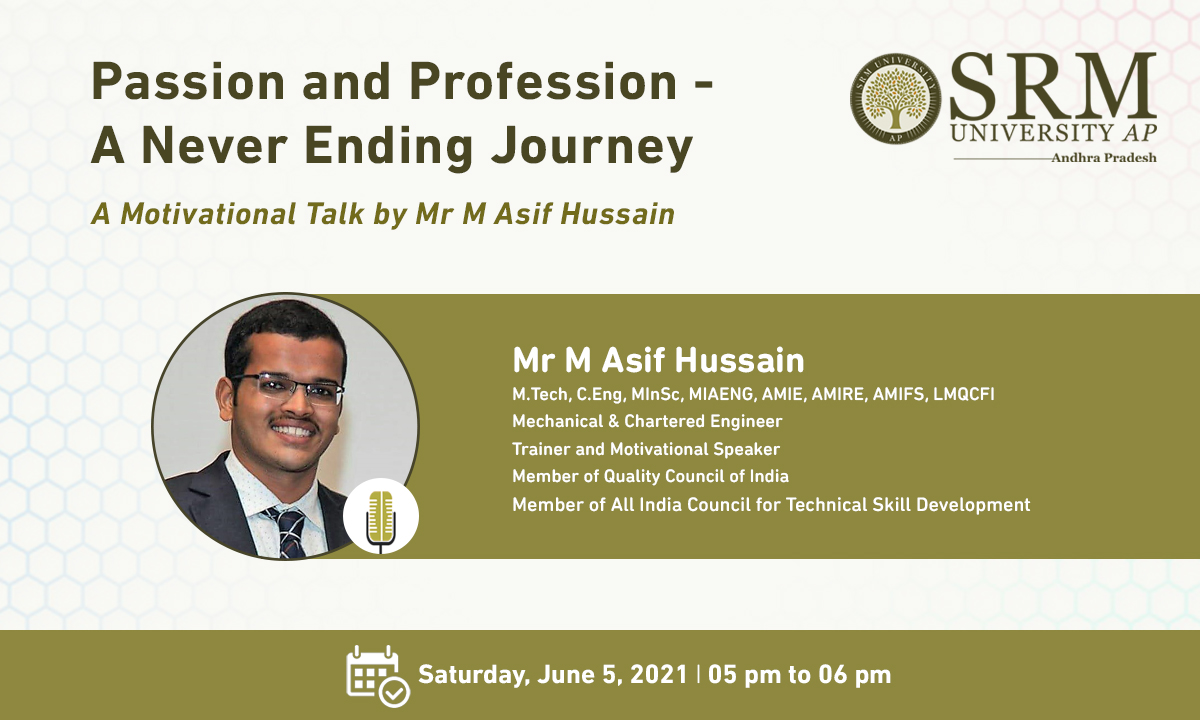 “All our dreams can come true if we have the courage to pursue them”, said Walt Disney, a pioneer of the American animation industry. Oftentimes we need a push forward to achieve our dreams and aspirations. A smart person is willing to listen, learn and respond efficiently to succeed in all aspects of their life. Mr Muddubhai Asif Hussain is such a young and vibrant personality who set foot in diverse professional arenas and achieved enviable success. Department of Student Affairs has scheduled an interactive motivational session with Mr Hussain on the topic “Passion and Profession-A Never Ending Journey” on June 5, 2021, at 5.00 pm for the students of our university. All students are invited to benefit from this worthwhile session. Let us Dream High, Stay Humble and Achieve Success.
“All our dreams can come true if we have the courage to pursue them”, said Walt Disney, a pioneer of the American animation industry. Oftentimes we need a push forward to achieve our dreams and aspirations. A smart person is willing to listen, learn and respond efficiently to succeed in all aspects of their life. Mr Muddubhai Asif Hussain is such a young and vibrant personality who set foot in diverse professional arenas and achieved enviable success. Department of Student Affairs has scheduled an interactive motivational session with Mr Hussain on the topic “Passion and Profession-A Never Ending Journey” on June 5, 2021, at 5.00 pm for the students of our university. All students are invited to benefit from this worthwhile session. Let us Dream High, Stay Humble and Achieve Success.About the Speaker: Mr Muddubhai Asif Hussain has been the District President of National Youth Council of India, District Advisor for World Human Rights Council, and a recipient of ‘InSc Young Achiever Award 2020’ from Institute of Scholars, Bangalore. A mechanical engineer by profession, Mr Hussain is building his prowess and passion as a Chartered Engineer, Social Activist, Philanthropist, Political Consultant, Strategic Planner, expert in Campaign Management, an Orator and a Motivational Speaker.
Continue reading → - Renowned physicists deliver talks at the “One-Day National Symposium on High Energy Physics.” June 4, 2021
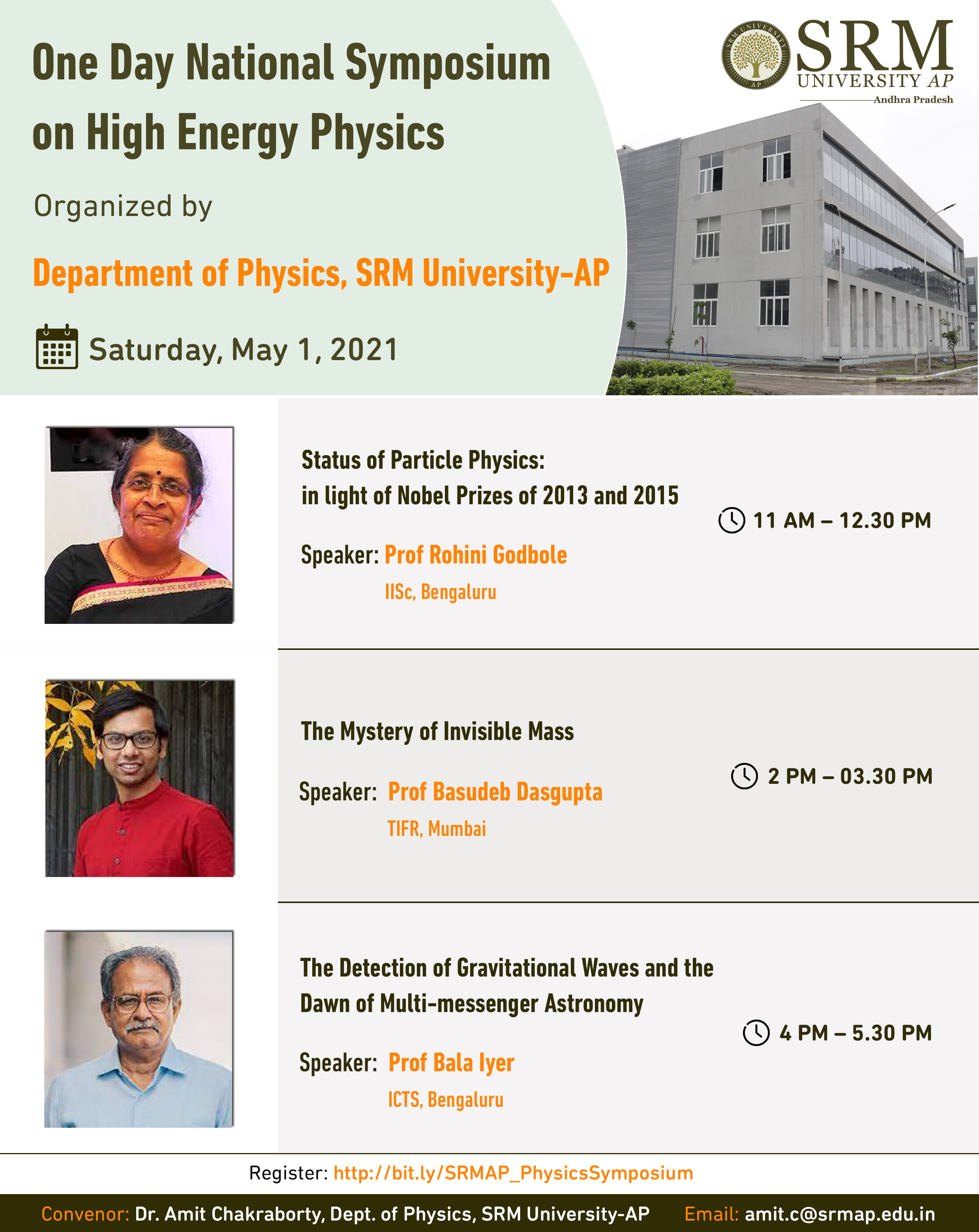 The Department of Physics, SRM University-AP organized a “One-day National Symposium on High Energy Physics” on Saturday, May 1, 2021. The session was held through online mode in the presence of honourable leaders of the university, faculty members, and attendees from various fields of interest. Prof V S Rao, the Vice-Chancellor, SRM University-AP, welcomed the gathering with a brief overview of the university’s inception and quick progress in the field of research.
The Department of Physics, SRM University-AP organized a “One-day National Symposium on High Energy Physics” on Saturday, May 1, 2021. The session was held through online mode in the presence of honourable leaders of the university, faculty members, and attendees from various fields of interest. Prof V S Rao, the Vice-Chancellor, SRM University-AP, welcomed the gathering with a brief overview of the university’s inception and quick progress in the field of research. Three talks at the pedagogical level were organised for a wider audience, especially for the students of basic sciences and engineering streams. The first speaker, a Padma Shri awardee, Prof Rohini Godbole, who is a theoretical particle physicist at Indian Institute of Science (IISc), Bengaluru expounded on “Status of Particle Physics: in light of Nobel Prizes of 2013 and 2015”. She talked about the Higgs Boson’s theoretical postulate, for which the Nobel Prize in Physics was granted in 2013. According to studies, it was the final missing element in the Standard Model’s periodic table (SM). Her paper incorporated the experimental finding of the Neutrino Oscillation, as well as many compelling pieces of evidence that led to the 2015 Nobel Prize.
In the afternoon session, the talks were on the burgeoning field of Dark Matter physics and Gravitational-wave astronomy. Prof Basudeb Dasgupta from Tata Institute of Fundamental Research (TIFR), Mumbai apprised the participants on “The Mystery of Invisible Mass”. The deep understanding and expertise of Prof Dasgupta in the interfaces of particle physics, astrophysics, and cosmology with a particular emphasis on dark matter and neutrino physics as a theoretical physicist at the Tata Institue of Fundamental Research (TIFR) enlightened the audience. He stated that the human beings are able to see only 20% of the universe’s celestial objects; the remaining 80% are unseen and are referred to as “dark matter.” In his words, “Billions of years after the Big Bang, all we can see is the cloud’s surface, where the light is scattered.” Prof Basudeb, is a frequent speaker at prestigious international and national conferences and is a youth icon for aspiring physicists and scientists.
The final lecture of the day was delivered by Prof Bala Iyer from International Centre for Theoretical Sciences (ICTS), Bengaluru on “The Detection of Gravitational Waves and the Dawn of Multi-messenger Astronomy” at 4.00 pm. Prof Iyer is currently the Simons Visiting Professor at ICTS-TIFR Bangalore and co-PI of the LIGO-India Scientific Collaboration. He coaches and guides young minds interested in astrophysics, cosmology, and fundamental physics. Prof Iyer did a presentation on the discovery of gravitational waves from a binary black hole in 2015, which was a watershed moment and necessitated the launch of a new multi-messenger astronomy with the potential to have a significant impact on astrophysics. “Any relativistic theory of gravity must be consistent with the special relativity principle. Gravity’s effect cannot travel faster than the speed of light. If an item’s gravitational field changes, the changes propagate over space and take a certain amount of time to reach the object “, he added.
The symposium that aimed to discuss the current status of exciting research topics of High Energy Physics concluded with a Q&A session. This has proved that the faculty members and participants were highly inspired and motivated after attending the symposium and listening to the scholars.
Pre-Event Release: https://arc2025.srmap.edu.in/events/national-symposium-on-high-energy-physics-2021/
Continue reading → - 3rd Year EEE Student Selected for Prestigious “INAE – Engineering Student Mentoring Programme” June 4, 2021
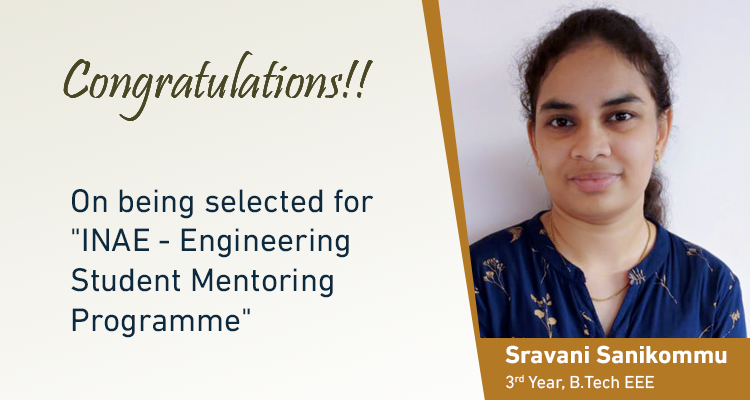 Ms Sravani Sanikommu, a vibrant and keen third-year Electrical and Electronics Engineering (EEE) student from SRM University-AP, has been selected for the prestigious Mentoring of Engineering Students by INAE Fellows Programme by the Governing Council of Indian National Academy of Engineering (INAE). She is one amongst 59 brilliant students who have been selected from across the country this year. The objective of this distinguished programme is to mentor outstanding B.E/BTech undergraduates by INAE fellows. Meritorious 3rd /4th year B.E./B. Tech students from recognised Engineering institutions are eligible under the scheme. Candidates must have a minimum of 75% or a CGPA of 7.5 to be considered for this programme. The mentorship program takes place through an online medium.
Ms Sravani Sanikommu, a vibrant and keen third-year Electrical and Electronics Engineering (EEE) student from SRM University-AP, has been selected for the prestigious Mentoring of Engineering Students by INAE Fellows Programme by the Governing Council of Indian National Academy of Engineering (INAE). She is one amongst 59 brilliant students who have been selected from across the country this year. The objective of this distinguished programme is to mentor outstanding B.E/BTech undergraduates by INAE fellows. Meritorious 3rd /4th year B.E./B. Tech students from recognised Engineering institutions are eligible under the scheme. Candidates must have a minimum of 75% or a CGPA of 7.5 to be considered for this programme. The mentorship program takes place through an online medium.The Governing Council of the Indian National Academy of Engineers (INAE) designed the mentoring programme to encourage future engineers in the nation to make significant contributions to engineering and technology for holistic solutions. Due to COVID-19 pandemic, online internship is also available. Ms Sravani gets an opportunity to work online in the host institution in the field of power electronics under the able mentorship of INAE Fellow Prof B G Fernandes, Electrical Engineering, Indian Institute of Technology Bombay (https://www.ee.iitb.ac.in/wiki/faculty/bgf) for 2 Months. She extended her gratitude to Dr Tousif Khan N, the Head of the Department, and Prof Sastry V Vedula, a distinguished visiting professor in the Department of Electrical and Electronics Engineering, as well as an INAE fellow, for initiating her into the mentoring programme and providing constant guidance.
Sravani stated that she had complete supervision of faculty members of SRM-AP during the preparation for this two month Mentoring Programme. The extensive research expertise of faculty members aided significantly throughout the selection process among the finest applicants. “I thank everybody who has put efforts into making this happen. SRMAP can provide such amazing opportunities to research in the fields in which students are interested in working. This is made possible through the faculty members who are experienced in the specified fields which helps the students to learn more about the subject and form a substantial idea on how the concepts work. If somebody is keenly interested in research on something they love and are very passionate about it, SRMAP is the right place!!”, said Ms Sravani with overwhelming enthusiasm.
Continue reading → - Spatial dimensions of Big Data jobs for efficient cluster job scheduling June 3, 2021
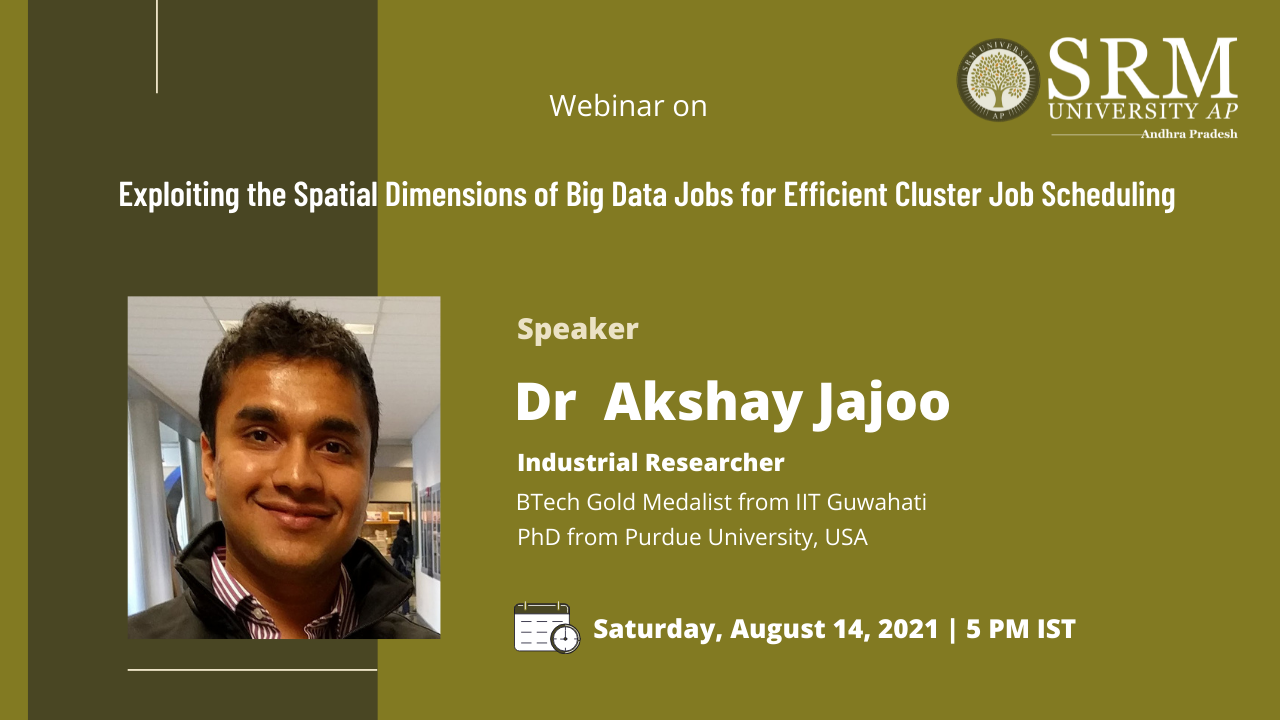 The Departments of Electrical and Electronics Engineering (EEE) and Computer Science and Engineering (CSE) jointly present a technical talk on “Exploiting the Spatial Dimensions of Big Data Jobs for Efficient Cluster Job Scheduling” on August 14, 2021, Saturday, at 5:00 pm (IST). Dr Akshay Jajoo, industrial researcher, will enlighten the students and researchers on his PhD thesis which focuses on developing novel learning and scheduling algorithms for distributed jobs in clouds.
The Departments of Electrical and Electronics Engineering (EEE) and Computer Science and Engineering (CSE) jointly present a technical talk on “Exploiting the Spatial Dimensions of Big Data Jobs for Efficient Cluster Job Scheduling” on August 14, 2021, Saturday, at 5:00 pm (IST). Dr Akshay Jajoo, industrial researcher, will enlighten the students and researchers on his PhD thesis which focuses on developing novel learning and scheduling algorithms for distributed jobs in clouds.The session, coordinated by Dr Tousif Khan N, Head of the Department of Electrical and Electronics Engineering, will cover the details of the concepts, use cases, and involved technology overview. Avid researchers and prospective industrialists are welcome to join the event.
About the Speaker:
Dr Jajoo earned his doctoral degree in computer science from the esteemed Purdue University, USA. His thesis proposes, validates, and designs systems that employ learning algorithms exploiting spatial dimensions. His research focussed on the use of spatial dimensions for efficient scheduling of distributed jobs and to speed up Coflows and big data jobs. While doing B. Tech at IIT Guwahati, he was awarded Gold Medal for academic achievement, extracurricular activities, and community service. On account of his outstanding academic record, Dr Jajoo was granted different scholarships to pursue research in France and Germany. He has also been a member of ISSA, ACM, and CERIAS.Link to Abstract: https://www.cs.purdue.edu/homes/ajajoo/finals/akshay_jajoo_phd_thesis_abstract.pdf
Registration Link: https://srmap.zoom.us/webinar/register/WN_tT6KBsWUSqG1TakZLD419g
Continue reading →

